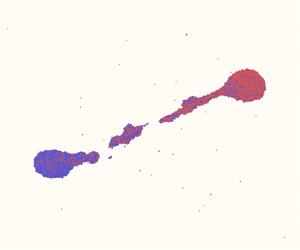Published online by Cambridge University Press: 11 January 2024

Binary nanodroplet collisions have received increasing attention, whilst the identification of collision outcomes and the viscous dissipation mechanism have remained poorly understood. Using molecular dynamics simulations, this study investigates binary nanodroplet collisions over wide ranges of Weber number (We), Ohnesorge number (Oh) and off-centre distances. Coalescence, stretching separation and shattering are identified; however, bouncing, reflexive separation and rotational separation reported for millimetre-sized collisions are not observed, which is attributed to the enhanced viscous effect caused by the ‘natural’ high-viscosity characteristics of nanodroplets. Intriguingly, as an intermediate outcome, holes form in retracting films at relatively high We, arising from the vibration and thermal fluctuation of the films. Due to the combined effects of inertial, capillary and viscous forces, binary nanodroplet collisions fall into the cross-over regime, so estimating viscous dissipation becomes extremely important for distinguishing outcome boundaries. Based on the criterion that stretching separation is triggered only when the residual off-centre kinetic energy exceeds the surface energy required for separation, the boundary equation between coalescence and stretching separation is established. Here, viscous dissipation is calculated by the extracted flow feature from simulations, showing that the ratio of viscous dissipation to the initial kinetic energy depends only on Oh, not on We. Because of complex viscous dissipation mechanisms, the same boundary equation in the cross-over regime has also not been satisfactorily revealed for macroscale collisions. Therefore, the proposed equation is tested for wide data sources from both macroscale and nanoscale collisions, and satisfying agreement is achieved, demonstrating the universality of the equation.